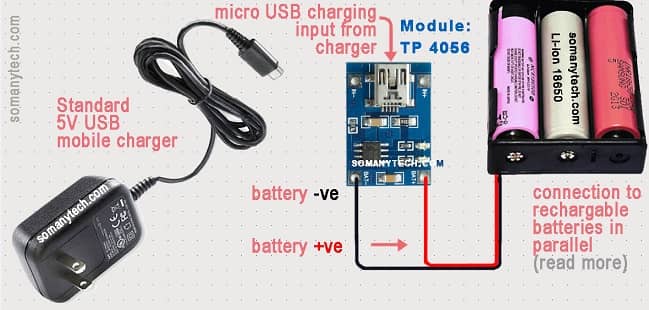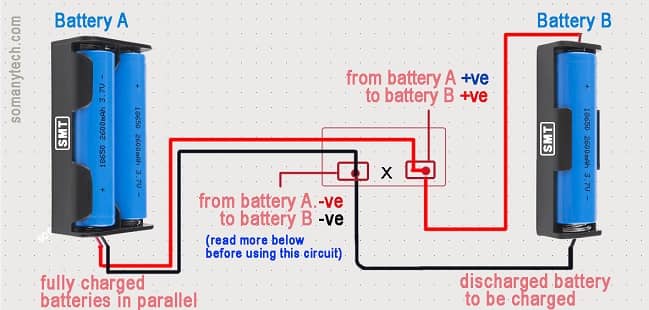5 Best Ways to Charge 18650 Battery
If you are searching for the correct method to charge 18650 battery then you landed on the correct post article. in this post we have explained the various method to 18650 battery how to charge with different modules, direct charge and without charger.
You find these batteries everywhere in most of the devices we use at home for domestic use, office use, industrial use, and most commonly in DIY projects by electronics and electrical engineers and enthusiasts. Sometimes we do buy the 18650 li-ion battery without buying a charger to recharge it, are unwilling to buy a charger at that time. so what if you drained the battery completely and want to use it again in a different project? you need to charge it!!
How to charge 18650 battery ?
As you all know 18650 is a rechargeable lithium-ion battery you simply won’t throw them in the dustbin when discharged. So just charge it using a 18650 battery charger commercially available in an online store or buy it from electronics component Stores.
Another method is to do it yourself at your place using already available devices and components like an old mobile phone charger or bench DC power supply, etc, which are discussed step-by-step in detail in sections below. Also check Simplest 18650 Battery Charger circuit with auto cutoff DIY
Theory on 18650 battery charging :
This theory is for brushing up knowledge on the battery’s state of charge, and battery charger circuits. we will only discuss how to charge the 18650 battery in detail without going deeply into the working of chargers/ battery.
Constant voltage and constant current
When the cell is given Constant voltage, the cell absorbs the constant^ current during charging. The cell can absorb as much current as it is given, but providing current more than rated value could reduce battery life or heat up quickly to damage the cell (check the datasheet for rated charging current).
^ almost constant during 20{42041a7992ac3be9e9e29c856254fb498d8c7935d7cf8512da6802e8688e734a} to 90{42041a7992ac3be9e9e29c856254fb498d8c7935d7cf8512da6802e8688e734a} of the state of charge, for more information, check the state of charge of lithium battery

Charging voltage:
The standard constant charging voltage varies from manufacturer to manufacturer but does not vary much, as it changes as 4.2V, 4.3V, and 4.4V. These are safe values, you can even charge with little higher voltages.
(You can also use 5V to charge 18650 cells. This will not damage the cell if you don’t allow it to overcharge, by terminating the charging and preventing damage to the cell after the li-ion cell reached 4.2 volts.) A standard charging value on the typical datasheet is generally mentioned at 0.5 C, where C stands for capacity. So the practical value of the charging current must be equal to or less than half the battery capacity mentioned.
For example, in a 1700 mAh cell, the standard charge current would be 850 mA, and for a 2400 mAh cell, the standard charge current would be 1200 mA.
It is recommended to keep the charging current at or below the limit specified in the datasheet.
(check 18650 battery specification and datasheet here)
When the battery voltage reaches 4.1 V or 4.2 V, the 18650 battery cell is almost fully charged. This may be called as 18650 battery charging voltage. From this moment, the current consumed by the battery starts decreasing steadily to reach a certain value*.
Charge termination:
When the current drops below or stays at a certain value*, charging should be terminated. The most commonly practiced charge current termination limits are between C/10 and C/30.
For example, in a 1700 mAh cell, the standard charge current would be 850 mA. Thus the charge termination current will be near 85mA and
For a 2400 mAh cell, the standard charge current would be 1200 mA, thus the charge termination current will be near 120mA.
Important before charging using methods mentioned on this page:
- When the battery is fully charged means reached charge current termination value, the battery should be disconnected immediately from the power source.If the battery is kept connected to the dc power source will cause the battery to overcharge and eventually it will swell, resulting in damage to the battery.
*check datasheet, click here for sample 18650 datasheet. - To avoid damage to the cell, use 18650 chargers with overcharge, over-current, over-voltage protection features. So you can rest assured of safety to the battery.
- Charging the 18650 battery without a charge controller (like tp4056, tp5100 etc.) is not advised due to the risk of overcharging and damages.
- Charging the 18650 battery without a charger is possible with the proper knowledge, precaution, and method we have shown below.
- If you are charging the 18650 battery without a charger then charge 1 cell at a time with the information given in the theory part above.
Charging with 18650 battery charger:
Use the charger shown in the image above, available for sale online on Amazon or eBay.
This is the simplest and best method to charge 18650 battery without concerning about the removal of the battery from the charger to protect it from overcharging, over-voltage, or short-circuit.

These chargers have an inbuilt over charging protection circuit and cut-off circuit that disconnects the battery when it is fully charged, which ensures the long life of the battery and performance.
It also comes with battery charging state display/ indicators, their function may vary from charger to charger.
There are two types of 18650 lithium-ion battery chargers available in the market:
- USB powered 18650 battery chargers: With these chargers, you can charge the battery from any USB power port/socket you see around. It is recommended to use your high current rated mobile charger to charge batteries with this device.
Otherwise, it will slow-charge the batteries or you can say slow charging. The good thing about this device it is highly portable you can carry it along traveling and use it with any type of USB port. - Mains power 18650 battery chargers: In this, you can directly connect the charger with a mains power supply that is available at your home. They could charge faster than USB-powered chargers.
How to charge 18650 battery using tp4056?
Component required: connecting wires, 18650 battery holder, tp4056 module, 5v mobile charger 1.0 Amp or more.
It’s very easy to use the tp4056 module. There is need to identify 2 terminals on the board viz. BAT+, BAT- only. Just connect the positive terminal of the battery to the BAT+ on the board and the negative terminal of the battery to the BAT- on the board as shown in the image below.
Now connect the micro USB charger to the charging port present on the module.
Link (Also check power bank circuit for the more in-depth perspective.)

Component required: 5V mobile phone charger (1Amps or more), connecting wires, 18650 battery holder, tp4056 module(required).
By doing connection shown in the above image, you can charge 18650 battery safely. If you are using low current rated mobile phone charger then charge only one 18650 lithium cell with it. As more cells will draw more current that can goes up more than 1 ampere, so there is a chance that your charger would heat up very quickly and get permanently damage.

This above image shown the detail of the terminals of tp4056 and final setup of 18650 charging circuit without cell holder.
Click here to check how to fast charge 18650 battery at 2000mA using IC TP5100
Charge 18650 battery without charger:
8650 battery charger using old phone charger or USB port

Component required: 5V mobile phone charger(capacity of 500mA or more), connecting wires, 18650 battery holder, tp4056 module(optional).
- Connect the circuit as shown in the above circuit, keep checking output voltage of the battery using a multimeter (charger disconnected) to read voltage of 4.2 volts.Remove battery at 4.1 volts, its recommended if you are not using any charge controller. (read theory above for safe operation)
- You can also charge 18650 battery using USB i.e, the output of USB port for charging. Use only one cell at a time.(connect charge controller module at ‘pt.1’ if possible for safe operation)
How to charge 18650 battery without charger?
Direct charge using fully charged 18650 battery:

This method could be rarely used for charging purposes, as it just shares power from the ‘fully charged battery’ to ‘discharged battery’. What if you don’t have any type of device or power source to charge a 18650 battery? then you can use this method to charge a completely discharged battery.
Component required: Fully charged batteries/ connecting wires, tp4056 module(optional)
Connect the circuit as shown in the above circuit for about 30 to 60 minutes. The completely discharged battery will acquire some charge from fully charged batteries. (connect charge controller module at ‘X’ if possible for safe operation)
18650 battery charger using bench DC power source (without charger)

You can charge a 18650 battery without charger if a DC bench power supply is available with you, but it is quite an unconventional method. It is to be used attentively while charging batteries with a bench DC power supply. Note that if you are not Experienced in electronics core electrical circuits and its rules, then avoid trying this!! if you overcharge or connect Lithium batteries in Reverse polarity, they may bulge or catch fire. It is recommended to charge one battery at a time, following steps and calculation values for one 18650 battery at a time.
Step1: Make sure that the power supply output voltage is at 4.3V before connecting to the battery.
Step2: Turn off the bench DC power supply from mains as well as from the bench unit before connecting wires.
Step3: Properly connect the positive terminal of the batteries to the positive terminal of the DC power supply, and connect the negative terminal of the battery to the terminal of the DC power supply. Make sure that connections are tight (not loose).
Step3: Turn on the switch & ensure 4.3v at the output.
Now monitor the reading of bench power supply according to the already discussed points in the theory part.
Here, (for single-cell) the initial current would be more than 400mA while charging. Disconnect the batteries when the current consumption ranges from 25 to 100mA (depends on battery capacity). This means that your battery is almost charged.
If you do not want to monitor and disconnect the battery manually then you can use a charge controller module like TP 4056. The charge controller will automatically control the current to the batteries and disconnect when fully charged. Also, it is safe!!




